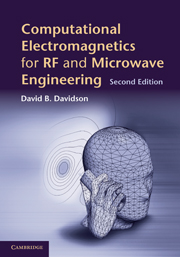Book contents
- Frontmatter
- Dedication
- Contents
- Preface to the second edition
- Preface to the first edition
- Acknowledgements
- To the reader
- List of notation
- 1 An overview of computational electromagnetics for RF and microwave applications
- 2 The finite difference time domain method: a one-dimensional introduction
- 3 The finite difference time domain method in two and three dimensions
- 4 A one-dimensional introduction to the method of moments: modelling thin wires and infinite cylinders
- 5 The application of the FEKO and NEC-2 codes to thin-wire antenna modelling
- 6 The method of moments for surface modelling
- 7 The method of moments and stratified media: theory
- 8 The method of moments and stratified media: practical applications of a commercial code
- 9 A one-dimensional introduction to the finite element method
- 10 The finite element method in two dimensions: scalar and vector elements
- 11 The finite element method in three dimensions
- 12 A selection of more advanced topics in full-wave computational electromagnetics
- Appendix A The Whitney element
- Appendix B The Newmark-β time-stepping algorithm References
- Appendix C On the convergence of the MoM Reference
- Appendix D Useful formulas for simplex coordinates
- Appendix E Web resources
- Appendix F MATLAB files supporting this text
- Index
- References
Appendix C - On the convergence of the MoM Reference
Published online by Cambridge University Press: 05 July 2014
- Frontmatter
- Dedication
- Contents
- Preface to the second edition
- Preface to the first edition
- Acknowledgements
- To the reader
- List of notation
- 1 An overview of computational electromagnetics for RF and microwave applications
- 2 The finite difference time domain method: a one-dimensional introduction
- 3 The finite difference time domain method in two and three dimensions
- 4 A one-dimensional introduction to the method of moments: modelling thin wires and infinite cylinders
- 5 The application of the FEKO and NEC-2 codes to thin-wire antenna modelling
- 6 The method of moments for surface modelling
- 7 The method of moments and stratified media: theory
- 8 The method of moments and stratified media: practical applications of a commercial code
- 9 A one-dimensional introduction to the finite element method
- 10 The finite element method in two dimensions: scalar and vector elements
- 11 The finite element method in three dimensions
- 12 A selection of more advanced topics in full-wave computational electromagnetics
- Appendix A The Whitney element
- Appendix B The Newmark-β time-stepping algorithm References
- Appendix C On the convergence of the MoM Reference
- Appendix D Useful formulas for simplex coordinates
- Appendix E Web resources
- Appendix F MATLAB files supporting this text
- Index
- References
Summary
Throughout this book, checking convergence numerically has been continually emphasized. However, we have not discussed the more theoretical issues of whether the underlying numerical formulations are indeed convergent, in the sense that the approximate numerical solution fN of the continuous operator equation Lf = g has the property fN → f as N → ∞. The aim of this appendix is to give a brief summary of the current status of this – which readers may be surprised to learn is far from a closed subject.
With the FDTD, the Lax equivalence theorem (discussed in Chapter 2) provides us with confidence that refining the FDTD mesh will indeed result in a convergent solution. With the FEM, work in applied mechanics has provided a rich set of convergence results — although we should note that convergence for high-frequency electromagnetics problems is often in terms of the energy norm, as discussed in Chapter 12. This is a slightly weaker statement of convergence, since the energy norm does not satisfy all the properties of the norm. Also, these proofs are usually in terms of interpolation error; as has been noted, dispersion (or pollution) error is a different problem specific to the differential equation based solvers, but can usually be controlled by adequate meshing.
- Type
- Chapter
- Information
- Computational Electromagnetics for RF and Microwave Engineering , pp. 489 - 490Publisher: Cambridge University PressPrint publication year: 2010



